2 中国科学院第四纪科学与全球变化卓越创新中心, 陕西 西安 710061;
3 青岛海洋科学与技术试点国家实验室海陆气候环境变化开放工作室, 山东 青岛 266061)
全球气候变化及其影响越来越受到社会各界的广泛关注,其未来变化趋势不仅会影响人类的生存环境及生态安全,对社会的可持续发展也提出了严峻的挑战。为了准确预测未来气候变化,达到有效应对的目的,首先必须摸清气候变化的历史本底,掌握其变化特征和规律,查明气候变化的影响因素和机制。气候变化存在不同的周期,某一特征气候态的出现很可能是多个周期影响的结果[1]。而现代气候观测记录多始于1950年代,过短的时间尺度无法揭示气候变化的不同周期特征,也无法探究气候变化的本质。因此,通过不同气候代用资料对现代观测记录进行拓展,开展过去百-千-万年-轨道尺度的气候变化研究十分必要[2~12]。对于短期气候预测而言,距我们现代生活最近的百-千年来的高分辨率气候重建尤为重要。
在所有的气候代用资料中,树木年轮以能够提供具有绝对年代标尺、具有年分辨率且连续的时间序列、可以与现代气候观测记录进行校验并能进行气候定量化重建等优势,在全球变化研究中发挥了重要作用[1, 2, 4~6, 9~16]。经过几代人的努力,代用气候记录倾向于进行更大空间尺度的区域集成[6, 8~12]。但是我们也应认识到大尺度的气候重建虽然有利于评估气候变化的总体特征,但是同时可能会掩盖局地气候变化的特色[17],这将对正确评估局地气候变化及其未来气候预测极为不利。因此,开展由点到面的气候重建研究仍十分必要。
目前,我国北亚热带地区的树轮气候学研究取得了一些进展[18~27],如在大别山[19, 20, 22]和神农架[24]地区开展了不同海拔高度树轮生长对气候变化响应的研究。虽然对一些采样点进行了季节性的气候(主要是气温)变化重建[18, 21, 23, 26~27],但是对最低温,尤其是夏季最低温重建的研究在我国北亚热带地区还较为缺乏。已有研究指出,最低、最高温及二者增温之间的不对称性变化都会对植被生长产生重要影响[28~30],且最低温对植被的影响在某些地区要超过最高温[28, 30]。可见开展我国北亚热带地区过去数百年来最低温重建工作是非常必要的。
呈西北-东南走向的桐柏山地处河南和湖北的交界,位于秦岭向大别山的过渡地带,也是暖温带向亚热带过渡的地区。桐柏山的主脊北侧大部分都在河南省境内。同时,它也是淮河与长江流域的分界。因此,桐柏山十分敏感的地理位置使得在这一区域开展历史气候变化研究意义重大。
本文研究目的:1)建立桐柏山地区树轮宽度年表,研究过去百年树木的生长特征;2)分析气候变化对树木生长的影响;3)重建桐柏山地区过去百年来的夏季最低气温变化历史,分析气候变化的年际和年代际特征,在此基础上探讨影响气候变化的可能因素。此外,Cai等[21]认为我国东部地区最近变暖的起始时间存在由北至南变晚的区域差异,其中在中部地区大概始于1970年代。本研究结果也将为验证这个结论提供一条新的来自北亚热带地区的证据。
1 材料与方法 1.1 研究区气候与树轮资料获取本研究所使用的马尾松树轮样本于2013年11月底采自河南南阳桐柏县淮源风景区(图 1,32.40°N,113.28°E;海拔510 m)。位于北亚热带的桐柏县属于季风型温湿气候,年平均气温约15 ℃,平均年降水总量约1168 mm。7月是降水最多(172.35 mm)也是最热(28 ℃)的月份;5月、6月气温较高,但相对湿度较低(图 2)。马尾松(Pinus massoniana Lamb.)是采样区的主要树种,生长在较为平缓(0°~5°坡度)的开阔地带,林间郁闭度约0.3,林下杂草茂盛,土壤层较厚。我们利用5 mm口径的生长锥在健康树的胸高位置从树干的不同方向取样,每树钻取2根树芯,从24棵树上共取得48根树芯样本。
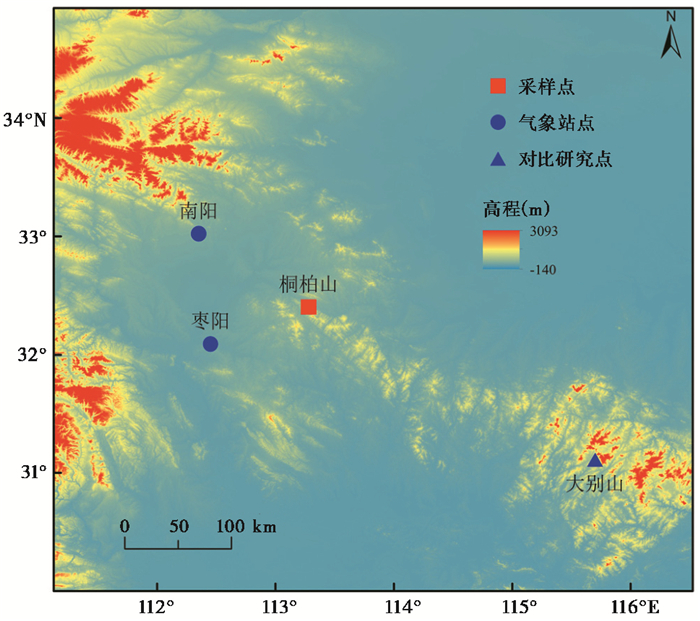
|
图 1 研究区示意图 Fig. 1 Map of the study area |
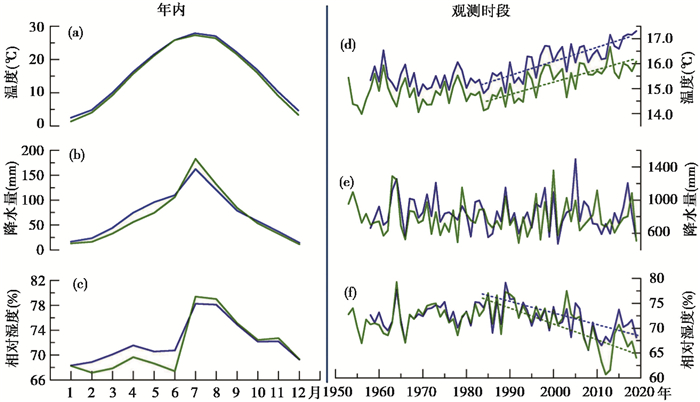
|
图 2 南阳(蓝)和枣阳(绿)气象站气候记录 (a~c)月平均气温、月降水量和月平均相对湿度分布;(d~f)两气象站在观测时段内年平均气温、年降水总量和年平均相对湿度记录,其中虚斜线代表气候要素变化的走向 Fig. 2 Climatic records of Nanyang(blue)and Zaoyang(green)meteorological stations.(a~c)Monthly distribution of mean temperature, precipitation amount and mean relative humidity; (d~f)The instrumental period records of annual mean temperature, annual total precipitation amount and annual mean relative humidity, and dotted line indicates trend of climatic factor |
将树芯样本粘贴在特制木槽上自然风干后,用不同粒度的砂纸将树芯表面磨平磨光,使年轮边界清晰可辨。首先我们对所有样本进行目测定年,然后利用LINTAB年轮测宽仪对所有树芯样本的年轮宽度(TRW)进行测量,获得48根树芯的TRW序列;之后再利用COFECHA程序[31]对初步定年的TRW序列进一步进行交叉定年,最终赋予每一个年轮绝对的日历年代。在交叉定年过程中,7根树芯样本因为树龄过短不利于去趋势后保留低频气候信号而被弃用,其余41根树芯的TRW序列(平均长度85.4年)平均相关系数达到0.59,平均敏感度为0.32,说明来自不同树芯的TRW宽窄变化比较同步,对外界共同影响因素(如气候)的响应比较敏感。因此,这41条TRW序列被用于建立TRW标准年表。
由于TRW序列除了包含气候信号外,还包含树木自身生长“幼龄效应”及树间竞争等所带来的低频影响[32],因此在使用之前需将之去除,即树轮年代学中所说的“标准化”。该标准化过程通过ARSTAN程序[33]完成。为了下文便于与其他地区研究[21]进行比较,在标准化过程中我们采用负指数函数或斜率为负的线性函数对树木的生长趋势进行拟合。鉴于所采集的样本树龄参差不齐,为了减少因早期样本量少而引起的方差大的问题,本文在年表研制过程中同时采用了稳定方差技术[34],且采用子样本信号强度超过0.75的阈值来确定标准树轮宽度年表可靠的起始年份[35~36]。
1.2 气候数据气候数据采用采样点附近的南阳(33.02°N,112.35°E;海拔129.2 m)和枣阳(32.09°N,112.45°E;海拔125.5 m)气象站的月降水量、月平均气温、月平均最高和最低气温及相对湿度记录。由图 2可以看出,两站的气候变化无论是在月尺度还是年尺度上都有很好的一致性,因此将两站的气候要素进行算术平均以获得区域气候记录。由于南阳站的记录始于1952年7月,枣阳站的记录始于1957年2月,我们最终获得了1957年2月到2019年的区域气候记录。
1.3 分析方法在建立高质量TRW年表的前提下,查明树木年轮如何对气候变化做出响应以及查明哪个气候因子对树木径向生长起着主要控制作用,这些对树轮气候学研究至关重要[32]。本文采用皮尔逊(Pearson)相关分析法,对TRW年表与上年10月到当年10月之间的各个月份、不同月份组合的气候要素的关系进行了分析,进而提取树木生长的限制气候因子,在建立转换方程的基础上对限制性气候因子的变化历史进行重建。对重建方程稳定性及重建结果可靠性的检验我们采用分段检验法[32]进行:将观测时段的前后25年分别设为校准期,其余的32年分别设为验证期进行检验。检验统计参数主要包括相关系数r、方差解释量R2、符号检验(ST)、误差缩减值(RE)和效率系数(CE)[32, 37]。对整个重建时段的检验则采用邻近地区的温度重建结果[21]来进行交叉验证。为了探讨研究区气候变化的可能影响因素,本文将桐柏山气温观测记录与全球海温进行空间相关分析,并将气温重建结果和大西洋多年代际振荡(Atlantic Multidecadal Oscilliation, 简称AMO)、北大西洋涛动(North Atlantic Oscilliation, 简称NAO)进行对比分析。空间相关分析在Climate Explorer网站(http://climexp.knmi.nl/)实现,所使用的AMO和NAO数据也来自该网站。
2 结果与讨论 2.1 树木的生长特征及控制树木径向生长的主要气候限制因子我们建立了桐柏山地区1897~2013年共117年的TRW年表,其中可靠年表始于1916年(图 3)。该年表的平均敏感度为0.24,标准差为0.37,一阶自相关系数为0.48,表明树轮宽度对外界气候环境变化影响比较敏感,且上一年度气候变化在一定程度上会影响当年树木的生长。选取1945~2011年这一时段对样本年轮宽度去趋势序列进行共同区间分析,所有样本、树间及树内的相关系数分别为0.39、0.39和0.65;样本量的总体代表性为0.93(一般>0.85即可),第一主成分所占方差量为41.66 %。这些统计参数表明用于年表研制的树轮宽度序列能够代表采样点树木群体的变化,生成的年表质量较高。
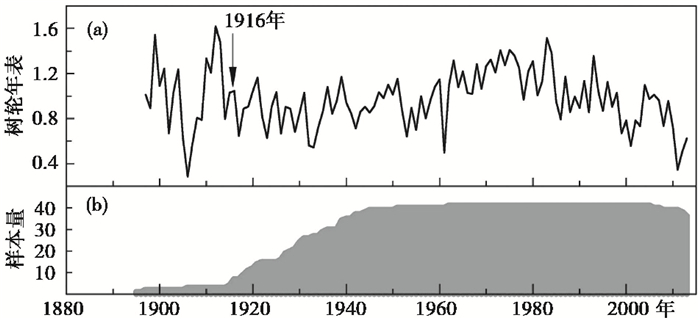
|
图 3 河南桐柏山1897~2013年树轮宽度年表(a)及样本量(b) 在(a)中,箭头所指为可靠年表的起始年代 Fig. 3 Tree-ring width chronology (a) and sample size (b) in the Tongbai Mountain, Henan Province from 1897 A.D. to 2013 A.D. Arrow points to the reliable starting year of the chronology in (a) |
统计相关分析结果表明,TRW年表对降水的响应不显著,而对当年大部分月份的气温(尤其是最低气温)和相对湿度都表现出非常显著的响应(图 4)。其中,TRW与2月至10月各月平均最低气温的负相关、与3月至10月各月相对湿度的正相关均达到了95 % 的置信度。在月份组合上,TRW年表和5~7月(夏季)平均最低气温(Tmin5~7)的相关最高,达到了-0.70(p < 0.01,n=57);与平均气温的最高相关时段是4~7月,相关系数达到-0.68(p < 0.01);与平均最高气温的最高相关时段也是4~7月,相关系数为-0.59(p < 0.01)。此外,我们也发现TRW年表与上年9月(P9)到当年8月的年平均最低气温的相关达到-0.67(p < 0.01)。TRW年表与4~9月和4~7月的平均相对湿度的相关系数均达到了0.58(p < 0.01)。在降水方面,TRW年表与上年9月~当年6月降水相关最高,达到0.39(p < 0.01),与当年2~10月的降水总量相关为0.35(p < 0.01)。
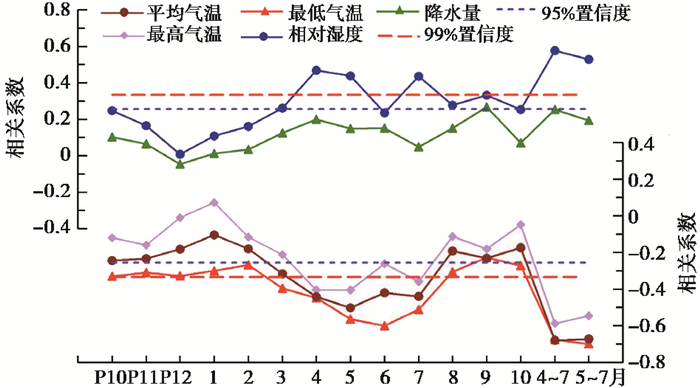
|
图 4 桐柏山树轮宽度年表与区域气候观测要素的相关分析结果(1957~2013年) P代表上一年 Fig. 4 Correlation analysis between tree-ring width chronology in the Tongbai Mountain and observed regional climatic factors (1957~2013 A.D.). P represents the previous year |
在马尾松长达百年的生长历史中,1953年之前的TRW波动比较稳定,没有明显的趋势性;1953~1983年TRW在波动中呈现持续升高的态势,之后持续在波动中下降。同时,我们发现在1953~1983年这个时段研究区气温和降水整体波动都不大(图 2d和2e),而相对湿度表现出显著的增加趋势(图 2f);1983年以后,尽管降水没有明显的增加或减少趋势,但是两个气象站的年均气温都表现出明显的升高趋势,即气候变暖导致同一时段的相对湿度显著下降。对比TRW年表和气候要素的变化趋势,可见树木的径向生长确实受到了气候变化、尤其是气温和相对湿度变化的影响。
这意味着在桐柏山这一年降水量丰富的地区,生长季降水完全可以持续稳定的满足树木生长需求,对树木生长不构成胁迫。而生长季及前期最高气温升高可能会导致土壤蒸发和树木自身的蒸发蒸腾作用加大,从而造成树木可有效利用的水分匮乏,给树木生长造成水分胁迫。这点从TRW与相对湿度的关系中也可以得到证实(图 4)。树木生长对气候的这种响应关系是我国亚热带低海拔地区[19, 22]及我国北方干旱半干旱区[6, 17, 36]树轮宽度气候学研究中的一种普遍现象,表明温度变化造成的水分胁迫对树木生长的限制作用。但是也有许多研究发现,最低温度对植物生长的影响要高于最高温度[28, 30]。由于树木一般在白天主要进行光合作用,积累生长所需的养分,而夜间则主要进行呼吸作用消耗光合作用的产物,使得分配到生殖器官中的生物量减少[30]。因此夜间温度(最低温度)越低(高)越有(不)利于抑制呼吸作用对有机物的分解,使得植物积累的净养分就越多(少),相应形成的年轮就宽(窄)[32]。本研究的相关分析结果也支持上述认识。
2.2 5~7月平均最低气温重建基于上述分析,利用TRW年表作为自变量设计简单线性回归方程(Tmin5~7=-2.267×TRW+22.683)对Tmin5~7进行重建。回归方程的相关系数为-0.70(p < 0.01),方差解释量为48.90 % (调整自由度后为48.00 %),F检验值为52.62。在有观测记录的时段,重建气温与观测记录之间的变化较为一致(图 5a),并且在高频(一阶差)变化上也保持较好的同步性(r=0.52,p < 0.01,图 5b)。
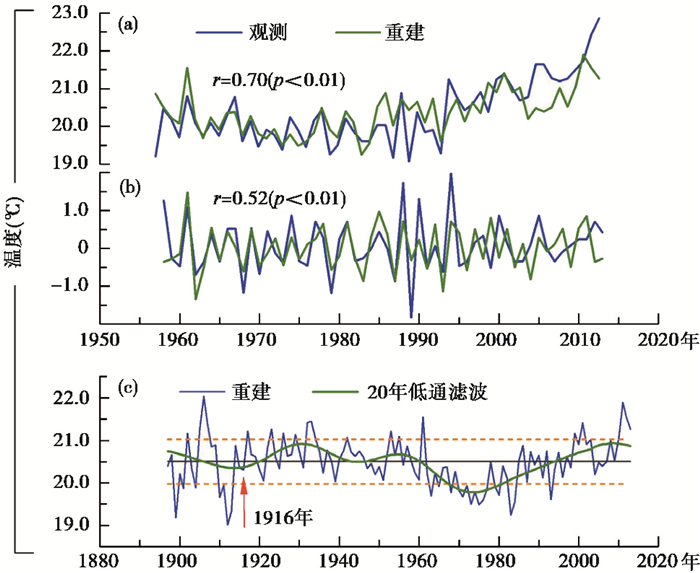
|
图 5 桐柏山过去百年5~7月平均最低气温重建 (a)和(b)分别为重建(绿色)和观测(蓝色)气温的原始和一阶差序列对比(1957~2013年);(c)1897~2013年的重建序列(蓝线),其中黑色横线为1916~2013年的平均值,桔色横虚线为均值±1个标准差,箭头指向重建的可靠开始年份1916年 Fig. 5 May-July mean minimum temperature reconstruction in the Tongbai Mountain. (a)Raw data and (b) first-order difference comparisons between reconstructed(green curve)and observed(blue curve)temperature during 1957~2013 A.D.; (c)Reconstructed temperature from 1897 A.D. to 2013 A.D.(blue curve). The horizontal black line indicates the mean value of the reconstruction during the reliable period 1916~2013 A.D., orange broken lines indicate mean ±1 σ(standard deviation). Arrow points to the reliable starting year of the reconstruction in 1916 A.D. |
从表 1可以看出,所有校准期和验证期的r值和R2值都达到了99 % 的置信度。对32年的验证时段来说,达到95 % 置信度的ST同号数应该是23[32],表 1中1982~2013年这一时段的ST未通过验证。误差缩减值(reduction of error,简称RE)和效率系数(coefficient of efficiency,简称CE)是两个硬指标。一般>0说明重建方程的重建结果对实际观测记录有较好的模拟技巧[37]。表 1中1982~2013年和1957~1988年这两个验证时段的RE值都大于0.3,只有1957~1988年这一验证时段的CE小于0。综合来看,利用该重建方程进行的气候重建是比较可靠的。
| 表 1 5~7月平均最低气温重建方程分段校验 Table 1 Split calibration-verification test for the May-July mean minimum temperature reconstruction |
鉴于亚热带地区高分辨率气候资料十分匮乏,为了尽可能的延长重建时段,我们对1897年以来的Tmin5~7进行了重建(图 5c)。在可靠的重建时段(1916~2013年),Tmin5~7在19.24 ℃和21.90 ℃之间变化,均值为20.50 ℃,标准差为0.53 ℃。如果以超出均值±1个标准差为异常年份[17, 21, 23],异常高温年份共有17年,其中6年(35.29 %)集中在1999~2013年;异常低温年份共16年,都集中在1963~1993年这个时段。
对重建气温序列进行20年低通滤波后,可以看到1962年之前研究区夏季相对温暖,没有极冷年份出现,而之后在1963~1993年出现了一个持续了31年的低温时段。2000~2013年属于过去百年中最暖的时期。从发展趋势来看,5~7月平均最低气温呈现“V”型变化,即1975年之前呈缓慢变冷过程,而后呈现变暖趋势。
2.3 区域气温对比在过去百年里,研究区重建气温与邻近大别山地区4~6月平均最高气温[21]相关系数达到0.35(p < 0.01 1916~2010年),即使在1897~2010年这个时段,相关系数也达99 % 的置信度(r=0.26)。20年低通滤波后可以看出两地的年代际气温变化非常同步,相关系数达到0.76(p < 0.01 1916~2010年)和0.78(p < 0.01 1897~2010年)。由图 6可见,同处于北亚热带的桐柏山和大别山都从1970年前后开始出现变暖趋势。这为我国东部地区最近增温的起始时间由北向南逐渐变晚[21]提供了一条来自中部地区的新的证据。此外,重建气温还与东南相距约580 km的江西三清山3~8月平均最高气温[38]的相关系数达到0.23/0.21 (1916/1897~2008年,p < 0.05),说明我国东南部亚热带地区夏季气温在较大尺度空间范围内变化有一定的同步性。

|
图 6 1897~2013年桐柏山5~7月平均最低气温(蓝)与大别山4~6月平均最高气温(绿)[21]对比 两者皆为20年低通滤波序列 Fig. 6 Comparison between the May-July minimum mean temperature(blue)in the Tongbai Mountain and the April-June maximum mean temperature(green)in the Dabie Mountains[21] from 1897 A.D. to 2013 A.D. All series are 20-year lowpass filter |
与全球海温的空间相关分析揭示桐柏山地区Tmin5~7观测记录(1957~2019年)和热带印度洋、热带及热带以外西太平洋(包括西太平洋暖池)海温在上年度各月份及当年7月份以前都显著正相关,与西太平洋的显著相关延伸到了约35°N的区域。为了给下文做铺垫,本文仅以上年5月~当年4月和上年5月~上年11月这两个时段为例(图 7)。我们的重建气温也表现出和观测气温记录一致的海温相关空间场(图 7c和7d)。热带印度洋-热带西太平洋的大部分区域也被称为亚-印-太交汇区[39],是影响我国乃至东亚短期气候异常的关键区。该区域的海温异常及海气交换过程可能会导致我国大范围的气象灾害。我国华北及亚热带其他地区的树轮研究都证实了气温变化与热带印度洋-热带西太平洋海温的联系[23, 40]。雷杨娜等[41]、Cai等[40]分析都认为当前及前期赤道印度洋和西太平洋暖池海温可以通过影响西太平洋和东亚地区的大气环流而影响我国夏季高温日数的频次及夏季温度的变化。

|
图 7 桐柏山地区5~7月(a,b)观测和(c,d)重建平均最低温与海温的空间相关图 其中观测气温为1957~2019年,重建气温为1957~2013年;(a)和(c)为上年5月~当年4月,(b)和(d)为上年5月~上年11月 Fig. 7 Spatial correlations between(a, b)observed(1957~2019 A.D.)and(c, d)reconstructed(1957~2013 A.D.)May-July mean minimum temperature of the Tongbai Mountain and global sea surface temperature. (a)and (c) indicate results of the period from previous May to current April, (c)and (d) indicate results of the period from previous May to previous November |
除了热带印度洋和西太平洋海温外,研究区夏季观测气温变化还与前期北大西洋海温存在显著联系(图 7)。大西洋多年代际振荡(AMO)和北大西洋涛动(NAO)是北大西洋海盆尺度分别以海温和大气环流异常为特征的气候变化模态。研究表明,北大西洋的热状态及其上空的对流活动对周边地区,也对东亚的气候变化起着十分重要的调制作用[42~44]。我们发现在过去百年,桐柏山地区气温重建序列与上年5~11月的NAO(NAOL5~11)关系最为密切(图 8),相关系数达到-0.44/-0.36 (1916/1897~2013年,p < 0.01),NAO与我国气温变化的负相关关系在其他地区也有报道[45~46],相关机制有待于进一步研究。
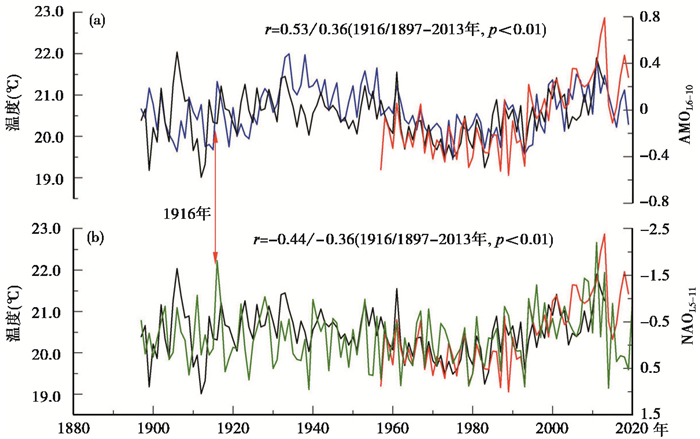
|
图 8 桐柏山重建(黑,1897~2013年)/观测(红,1957~2019年)气温与上年6~10月北大西洋年代际振荡(AMOL6~10)(蓝)和上年5~11月北大西洋涛动(NAOL5~11)(绿)对比 1916年以后为可靠气温重建时段 Fig. 8 Comparisons between the reconstructed(black, 1897~2013 A.D.)/observed(red, 1957~2019 A.D.)temperature in the Tongbai Mountain and Atlantic Multidecadal Oscillation index(blue)in the previous June-October(AMOL6~10), and the North Atlantic Oscillation(green)during the previous May-November(NAOL5~11). The temperature reconstruction is reliable after 1916 A.D. |
另外,重建气温与上年10月的AMO相关最高,达到了0.54/0.37 (1916/1897~2013年,p < 0.01)。在季节尺度上重建气温与上年6~10月AMO(AMOL6~10)关系最为密切(图 8),相关系数达到0.53/0.36 (1916/1897~2013年,p < 0.01),这一时段与NAO的显著相关时段基本一致;与上年5月至当年4月AMO相关也达到了99 % 的置信度水平(r=0.50/0.36 1916/1897~2013年)。在有气候观测记录的时段(1957~2019年),AMOL6~10与Tmin5-7的相关则达到0.62(p < 0.01)。尤其值得指出的是2010年以后桐柏山夏季最低气温的变化与AMOL6~10非常同步,甚至比其与NAO的关系更为紧密(图 8)。大气对海温强迫的响应是一个快速过程,当北大西洋海温发生异常变化后,大气对之做出快速响应,进而影响到冬季、甚至次年夏季中国的气温变化。因此AMOL6~10对研究区次年5~7月最低气温变化有显著影响是合理的。然而,李双林等[47]研究却发现近500年来一直存在东亚气温领先AMO变化5~7年的现象,这似乎否定了AMO变化影响东亚气温的观点。为了进一步深入理解东亚气候与AMO的关系,本文又计算了桐柏山Tmin5~7与AMO滞后4~10年的关系,发现二者间的相关系数在0.08~0.26(p>0.01)之间变化,远低于重建气温与上一年AMO的相关系数。由此可见,过去百年来在年际尺度上AMO与研究区气温变化确实存在一定关联,但是AMO变化并非滞后,而是超前研究区气温变化约1年,这一观点也被Cai等[17]在黄土高原东侧吕梁山地区的研究所证实。
3 结论本文利用采自河南桐柏山的41根马尾松树芯样本,在准确定年的基础上,建立了该地1897~2013年长达百年的树轮宽度年表。在与现代气候要素(1957~2013年)进行相关分析的基础上,发现桐柏山树轮宽度生长主要受生长季气温,尤其是最低气温(r=-0.70,p < 0.01)变化的影响,与降水的关系不显著。基于统计分析结果,本文重建了过去百年来桐柏山地区5~7月平均最低气温变化历史,发现在重建时段存在一个持续了31年(1963~1993年)的低温时期,而2000~2013年属于气温偏高的时期。从发展趋势来看,研究区气温呈现“V”型变化,即1975年之前呈缓慢变冷过程,而后呈现变暖趋势。与我国亚热带其他地区气温重建结果的对比分析揭示过去百年来亚热带地区较大范围内夏季气温变化在年与年代际尺度上有很大的相似性。进一步分析揭示研究区夏季最低气温变化不仅与亚-印-太交汇区海温变化密切相关,同时还受到上一年北大西洋海盆尺度气候变化模态(AMO,NAO)的影响。
致谢: 感谢审稿专家和编辑部杨美芳老师提出的宝贵建设性修改意见!
| [1] |
Liu Y, Cai Q F, Song H M, et al. Amplitudes, rates, periodicities and causes of temperature variations in the past 2485 years and future trends over the central-eastern Tibetan Plateau[J]. Chinese Science Bulletin, 2011, 56(28-29): 2986-2994. DOI:10.1007/s11434-011-4713-7 |
| [2] |
Fang K Y, Chen D L, Li J B, et al. Covarying hydroclimate patterns between monsoonal Asia and North America over the past 600 years[J]. Journal of Climate, 2014, 27(21): 8017-8033. DOI:10.1175/JCLI-D-13-00364.1 |
| [3] |
Guo Z T, Ruddiman W F, Hao Q Z, et al. Onset of Asian desertification by 22 Myr ago inferred from loess deposits in China[J]. Nature, 2002, 416(6877): 159-163. DOI:10.1038/416159a |
| [4] |
Liang E Y, Dawadi B, Pederson N, et al. Strong link between large tropical volcanic eruptions and severe droughts prior to monsoon in the central Himalayas revealed by tree-ring records[J]. Science Bulletin, 2019, 64(14): 1018-1023. DOI:10.1016/j.scib.2019.05.002 |
| [5] |
Liu Y, Cobb K M, Song H M, et al. Recent enhancement of central Pacific El Niño variability relative to last eight centuries[J]. Nature Communications, 2017, 8: 15386. DOI:10.1038/ncomms15386 |
| [6] |
Liu Y, Song H M, An Z S, et al. Recent anthropogenic curtailing of Yellow River runoff and sediment load is unprecedented over the past 500 years[J]. Proceedings of the National Academy of Sciences of the United States of America, 2020, 117(31): 18251-18257. DOI:10.1073/pnas.1922349117 |
| [7] |
Sun Y B, Yin Q Z, Crucifix M, et al. Diverse manifestations of the mid-Pleistocene climate transition[J]. Nature Communications, 2019, 10: 352. DOI:10.1038/s41467-018-08257-9 |
| [8] |
葛全胜, 郑景云, 方修琦, 等. 过去2000年中国东部冬半年温度变化[J]. 第四纪研究, 2002, 22(2): 166-173. Ge Quansheng, Zheng Jingyun, Fang Xiuqi, et al. Temperature changes of winter-half-year in Eastern China during the past 2000 years[J]. Quaternary Sciences, 2002, 22(2): 166-173. DOI:10.3321/j.issn:1001-7410.2002.02.010 |
| [9] |
Büntgen U, Tegel W, Nicolussi K, et al. 2500 years of European climate variability and human susceptibility[J]. Science, 2011, 331(6017): 578-582. DOI:10.1126/science.1197175 |
| [10] |
Linderholm H W, Nicolle M, Francus P, et al. Arctic hydroclimate variability during the last 2000 years: Current understanding and research challenges[J]. Climate of the Past, 2018, 14(4): 473-514. DOI:10.5194/cp-14-473-2018 |
| [11] |
Yang B, Qin C, Wang J L, et al. A 3, 500-year tree-ring record of annual precipitation on the northeastern Tibetan Plateau[J]. Proceedings of the National Academy of Sciences of the United States of America, 2014, 111(8): 2903-2908. DOI:10.1073/pnas.1319238111 |
| [12] |
Zhang Q B, Evans M N, Lyu L X. Moisture dipole over the Tibetan Plateau during the past five and a half centuries[J]. Nature Communications, 2015, 6: 8062. DOI:10.1038/ncomms9062 |
| [13] |
蔡秋芳, 刘禹. 山西五鹿山油松树轮宽度年表的建立及过去百余年5-6月平均气温变化[J]. 第四纪研究, 2013, 33(3): 511-517. Cai Qiufang, Liu Yu. The development of a tree-ring width chronology and the May-June mean temperature variability in Wulu Mountain, Shanxi Province of north-Central China[J]. Quaternary Sciences, 2013, 33(3): 511-517. DOI:10.3969/j.issn.1001-7410.2013.03.11 |
| [14] |
方克艳, 周非飞, 董志鹏, 等. 器测和树轮资料对厄尔尼诺-南方涛动指数的响应特征[J]. 第四纪研究, 2017, 37(5): 1064-1076. Fang Keyan, Zhou Feifei, Dong Zhipeng, et al. Responses of instrumental and tree-ring data to different indices of the El Niño-South Oscillation (ENSO)[J]. Quaternary Sciences, 2017, 37(5): 1064-1076. |
| [15] |
贾飞飞, 鲁瑞洁, 高尚玉. 腾格里沙漠南缘哈思山树轮记录的NDVI变化[J]. 第四纪研究, 2018, 38(2): 327-335. Jia Feifei, Lu Ruijie, Gao Shangyu. Variations of NDVI recorded by tree-ring in the Hasi Mountain, the southern margin of the Tengger Desert[J]. Quaternary Sciences, 2018, 38(2): 327-335. |
| [16] |
于健, 林万众, 闫伯前, 等. 基于树木年轮重建秦岭太白山1872年以来6-8月最低温度变化[J]. 第四纪研究, 2018, 38(4): 971-980. Yu Jian, Lin Wanzhong, Yan Boqian, et al. Tree-ring reconstruction of June-August mean minimum temperature back to 1872 A.D. in the Qinling Mountains, Northwest China[J]. Quaternary Sciences, 2018, 38(4): 971-980. |
| [17] |
Cai Q F, Liu Y, Zhang H Y, et al. Evolution of the dry-wet variations since 1834 CE in the Lüliang Mountains, North China and its relationship with the Asian summer monsoon[J]. Ecological Indicators, 2021, 121: 107089. DOI:10.1016/j.ecolind.2020.107089 |
| [18] |
陈秋艳, 勾晓华, 张军周, 等. 树轮宽度指示的神农架地区过去172年的冬春季温度变化[J]. 第四纪研究, 2015, 35(5): 1145-1154. Chen Qiuyan, Gou Xiaohua, Zhang Junzhou, et al. Tree ring indicated of winter-spring temperature in Shennongjia Mountain area of Central China over the past 172 years[J]. Quaternary Sciences, 2015, 35(5): 1145-1154. |
| [19] |
彭剑峰, 孙小华, 王飞, 等. 西大别山百战坪黄山松径向生长对气候因子的响应[J]. 生态环境学报, 2013, 22(11): 1769-1773. Peng Jianfeng, Sun Xiaohua, Wang Fei, et al. Climatic signals from the radial growth of Huangshan pine (Pinus taiwanese's Hayata) in the western Dabie Mountains[J]. Ecology and Environmental Sciences, 2013, 22(11): 1769-1773. DOI:10.3969/j.issn.1674-5906.2013.11.004 |
| [20] |
彭剑峰, 王婷. 黄柏山树轮生长对气候因子的响应及模拟[J]. 地理科学, 2015, 35(5): 644-651. Peng Jianfeng, Wang Ting. Response and model of tree-rings growth to climate factors at Huangbaishan Mountain in Henan Province[J]. Scientia Geographica Sinica, 2015, 35(5): 644-651. |
| [21] |
Cai Q F, Liu Y, Duan B C, et al. Regional difference of the start time of the recent warming in Eastern China: Prompted by a 165-yr temperature record deduced from tree rings in the Dabie Mountains[J]. Climate Dynamics, 2018, 50: 2157-2168. DOI:10.1007/s00382-017-3741-7 |
| [22] |
Cai Q F, Liu Y, Qian H J, et al. Inverse effects of recent warming on trees growing at the low and high altitudes of the Dabie Mountains, subtropical China[J]. Dendrochronologia, 2020, 59: 125649. DOI:10.1016/j.dendro.2019.125649 |
| [23] |
Cai Q F, Liu Y, Wang Y C, et al. Recent warming evidence inferred from a tree-ring-based winter-half year minimum temperature reconstruction in northwestern Yichang, South Central China, and its relation to the large-scale circulation anomalies[J]. International Journal of Biometeorology, 2016, 60: 1885-1896. DOI:10.1007/s00484-016-1175-2 |
| [24] |
Dang H S, Zhang Y J, Zhang K R, et al. Climate-growth relationships of subalpine fir(Abies fargesii) across the altitudinal range in the Shennongjia Mountains, Central China[J]. Climatic Change, 2013, 117: 903-917. DOI:10.1007/s10584-012-0611-5 |
| [25] |
Xu Y, Li W J, Shao X M, et al. Long-term trends in intrinsic water-use efficiency and growth of subtropical Pinus tabulaeformis Carr. and Pinus taiwanensis Hayata in Central China[J]. Journal of Soils and Sediments, 2014, 14: 917-927. DOI:10.1007/s11368-014-0878-4 |
| [26] |
Shi J F, Cook E R, Li J B, et al. Unprecedented January-July warming recorded in a 178-year tree-ring width chronology in the Dabie Mountains, Southeastern China[J]. Palaeogeography, Palaeoclimatology, Palaeocology, 2013, 381-382: 92-97. DOI:10.1016/j.palaeo.2013.04.018 |
| [27] |
Zheng Y H, Zhang Y, Shao X M, et al. Temperature variability inferred from tree-ring widths in the Dabie Mountains of subtropical central China[J]. Trees, 2012, 26: 1887-1894. DOI:10.1007/s00468-012-0757-9 |
| [28] |
曾红霞, 刘强, 赵强. 西北地区昼夜增温的不对称性对植被动态的影响[J]. 生态环境学报, 2019, 28(2): 260-265. Zeng Hongxia, Liu Qiang, Zhao Qiang. Asymmetry of day and nighttime warming and their effects on vegetation dynamics in the inland areas of Northwest China[J]. Ecology and Environmental Sciences, 2019, 28(2): 260-265. |
| [29] |
Peng S S, Piao S L, Ciais P, et al. Asymmetric effects of daytime and night-time warming on Northern Hemisphere vegetation[J]. Nature, 2013, 501(7465): 79-99. DOI:10.1038/nature12491 |
| [30] |
景盼盼. 植物生理生态性状响应夜温变化的整合分析和模型模拟[D]. 南京: 南京信息工程大学硕士学位论文, 2017: 1-144. Jing Panpan. A Meta-analysis and Model Simulation of Plant Ecophysiological Responses to Night Temperature Change[D]. Nanjing: The Thesis for Master's Degree of Nanjing University of Information Science & Technology, 2017: 1-144. |
| [31] |
Holmes R L. Computer-assisted quality control in tree-ring dating and measurement[J]. Tree Ring Bulletin, 1983, 43: 69-75. DOI:10.1006/biol.1999.0214 |
| [32] |
Fritts H C. Tree Rings and Climate[M]. New York: Academic Press, 1976: 1-584.
|
| [33] |
Cook E R, Kairiukstis L A. Methods of Dendrochronology: Applications in the Environmental Sciences[M]. Dordrecht: Kluwer Academic Publishers, 1990: 1-394.
|
| [34] |
Osborn T J, Briffa K R, Jones P D. Adjusting variance for sample-size in tree-ring chronologies and other regional mean timeseries[J]. Dendrochronologia, 1997, 15: 89-99. |
| [35] |
Wigley T M L, Briffa K R, Jones P D. On the average value of correlated times series, with applications in dendroclimatology and hydrometeorology[J]. Journal of Applied Meteorology and Climatology, 1984, 23(2): 201-213. DOI:10.1175/1520-0450(1984)023<0201:OTAVOC>2.0.CO;2 |
| [36] |
Liu Y, Cai Q F, Park W-K, et al. Tree-ring precipitation records from Baiyinaobao, Inner Mongolia since A.D. 1838[J]. Chinese Science Bulletin, 2003, 48(11): 1140-1145. DOI:10.1007/BF03185769 |
| [37] |
Cook E R, Meko D M, Stahle D W, et al. Drought reconstructions for the continental United States[J]. Journal of Climate, 1999, 12(4): 1145-1162. DOI:10.1175/1520-0442(1999)012<1145:DRFTCU>2.0.CO;2 |
| [38] |
Cai Q F, Liu Y. Two centuries temperature variations over subtropical Southeast China inferred from Pinus taiwanensis Hayata tree-ring width[J]. Climate Dynamics, 2017, 48(5-6): 1813-1825. DOI:10.1007/s00382-016-3174-8 |
| [39] |
吴国雄, 李建平, 周天军, 等. 影响我国短期气候异常的关键区: 亚印太交汇区[J]. 地球科学进展, 2006, 21(11): 1109-1118. Wu Guoxiong, Li Jianping, Zhou Tianjun, et al. The key region affecting the short term climate variations in China: The joining area of Asia and Indian-Pacific Ocean[J]. Advances in Earth Science, 2006, 21(11): 1109-1118. DOI:10.3321/j.issn:1001-8166.2006.11.002 |
| [40] |
Cai Q F, Liu Y, Liu H, et al. Reconstruction of drought variability in North China and its association with sea surface temperature in the joining area of Asia and Indian-Pacific Ocean[J]. Palaeogeography, Palaeoclimatology, Palaeogeoecology, 2015, 417: 554-560. DOI:10.1016/j.palaeo.2014.10.021 |
| [41] |
雷杨娜, 龚道溢, 张自银, 等. 中国夏季高温日数时空变化及其环流背景[J]. 地理研究, 2009, 28(3): 653-662. Lei Yangna, Gong Daoyi, Zhang Ziyin, et al. Spatial-temporal characteristics of high-temperature events in summer in Eastern China and the associated atmospheric circulation[J]. Geographical Research, 2009, 28(3): 653-662. DOI:10.3321/j.issn:1000-0585.2009.03.010 |
| [42] |
李双林, 王彦明, 郜永琪. 北大西洋年代际振荡(AMO)气候影响的研究评述[J]. 大气科学学报, 2009, 32(3): 458-465. Li Shuanglin, Wang Yanming, Gao Yongqi. A review of the researches on the Atlantic Multidecadal Oscillation (AMO) and its climate influence[J]. Transactions of Atmospheric Sciences, 2009, 32(3): 458-465. DOI:10.3969/j.issn.1674-7097.2009.03.014 |
| [43] |
谭亮成, 蔡演军, 安芷生, 等. 石笋氧同位素和微量元素记录的陕南地区4200-2000 a B. P. 高分辨率季风降雨变化[J]. 第四纪研究, 2014, 34(6): 1238-1245. Tan Liangcheng, Cai Yanjun, An Zhisheng, et al. High-resolution monsoon precipitation variations in southern Shaanxi, Central China during 4200-2000 a B. P. as revealed by speleothem δ18O and Sr/Ca records[J]. Quaternary Sciences, 2014, 34(6): 1238-1245. |
| [44] |
Liu Y, Ren M, Li Q, et al. Tree-ring δ18O-based July-August relative humidity reconstruction on Mt. Shimen, China, for the last 400 years[J]. Atmospheric Research, 2020, 243: 105024. DOI:10.1016/j.atmosres.2020.105024 |
| [45] |
Cai Q F, Liu Y, Fang C X, et al. Ground surface temperature reconstruction for the Jinggangshan Mountains: Interpreting the hydro-thermal coupling pattern in Southeastern China[J]. Quaternary Science Reviews, 2020, 249: 106591. DOI:10.1016/j.quascirev.2020.106591 |
| [46] |
Liu Y, Sun C F, Li Q, et al. A Picea crassifolia tree-ring width-based temperature reconstruction for the Mt. Dongda region, Northwest China, and its relationship to large-scale climate forcing[J]. PloS One, 2016, 11(8): e0160963. DOI:10.1371/journal.pone.0160963 |
| [47] |
李双林, 井元元, 罗菲菲. 工业革命前中国气温与大西洋年代际振荡(AMO)的可能联系[J]. 中国科学: 地球科学, 2015, 58(6): 864-878. Li Shuanglin, Jing Yuanyuan, Luo Feifei. The potential connection between China surface air temperature and the Atlantic Multidecadal Oscillation (AMO) in the pre-industrial period[J]. Science China: Earth Sciences, 2015, 58(10): 1814-1826. |
2 CAS Center for Excellence in Quaternary Science and Global Change, Chinese Academy of Sciences, Xi'an 710061, Shaanxi;
3 Open Studio for Oceanic-Continental Climate and Environment Changes, Pilot National Laboratory for Marine Science and Technology(Qingdao), Qingdao 266061, Shandong)
Abstract
Global climate change is having an unprecedented impact on human living condition, ecological security and social sustainable development. In order to effectively predict and better cope with future climate change, high resolution climate reconstructions from centennial-to millennial-scale are greatly needed. Located in the transition zone from warm temperate area to subtropics, the Tongbai mountain, stretching from northwest to southeast, is also the boundary between the Huaihe River and the Yangtze River Basins. Therefore, it has great scientific value to carry out palaeoclimatological studies in this area. High-resolution and well-dated tree rings have been used to investigate the climate-tree growth relationship and to reconstruct the history of climate change in the past few hundred years in subtropical China. However, summer minimum temperature, which is very important to vegetation growth, is less investigated in the north subtropics.In the present work, based on 41 successfully cross-dated Pinus massoniana Lamb. tree-ring samples collected from the Tongbai Mountain(32.40°N, 113.28°E; 510 m a.s.l.), we developed a standard tree-ring-width chronology(TRW) spanning 1897~2013 A.D. Correlation analysis between TRW and instrumental climatic factors during 1957~2013 A.D. reveals that growing-season temperature, particularly May-July mean minimum temperature(Tmin5~7), limits the radial growth of tree in the study area(r=-0.7, p < 0.01). We therefore reconstructed the history of Tmin5~7 variation for the past century. The reconstructed temperature can explain 48.90% of the instrumental data. It varies between 19.24℃ and 21.90℃ during the reliable reconstructed period(1916~2013 A.D.), with a mean value of 20.50℃, and a standard deviation of 0.53℃. A slowly cooling trend before 1975 A.D. and a warming trend thereafter are seen in the reconstruction. In the past century, 1963~1993 A.D. is comparatively cold, and 2000~2013 A.D. is the warmest. Spatial correlation patterns reveal that Tmin5~7 in the study area is closely linked to the sea surface temperature(SST) variations in the joining area of Asia and Indian-Pacific Ocean and the North Atlantic Ocean. Moreover, air-sea interaction in the North Atlantic Ocean(AMO, NAO) may also played an important role in modulating Tmin5~7 variation over the last hundred years. 2021, Vol.41
2021, Vol.41
